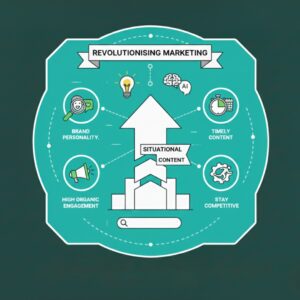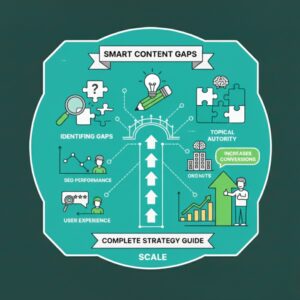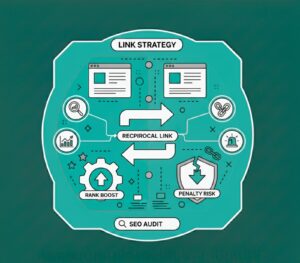Mastering Content Strategy 2025: A Complete Guide to Building, Planning & Growing Your Brand
Blogs | Category
Written By: Lauren Davison
Introduction
Content is everywhere, but not all content works. The content strategy 2025 is not about posting more. It is about making every word count. Some days you plan and things succeed. But sometimes you might fail. Both teach you lessons.
In this blog, you will see the parts of a strong content strategy. You will learn a step-by-step content strategy and trends, which help you to avoid mistakes.
It is not about fancy terms or big ideas. It is about ideas that stick, reach people, and grow your brand. It helps your brand achieve quick wins and long-term moves.
Table of Contents
What Is a Content Strategy, and Why It Matters in 2025
Content is more than words. It’s the way a brand talks, teaches, inspires, and connects. Every post, video, or story has a reason. Some answer questions. Some solve problems. Some make people curious. Success and failure both teach lessons.
A good content strategy links SEO, branding, and engagement. SEO isn’t just keywords; it’s understanding what people actually want. Branding shapes your voice. It helps people recognise and trust you. Engagement turns clicks into fans. Comments, shares, and reactions show what works.
Today, user intent is key. People ignore generic content. They want answers made for them. Personalised content keeps attention and builds loyalty. Brands that focus on real needs grow faster.
The Evolution of Content: From Blogs to AI-Powered Experiences
Content keeps changing. Blogs came first. Then social media. Then analytics, schedules, and posting routines. Now AI and personalisation dominate. Content adjusts to clicks, searches, and shares.
Brands now use tools to predict behaviour. AI suggests topics, timing, and formats. Data reveals which headlines and images convert. Testing and listening matter more than ever.
Why Content Strategy Drives Digital Success
Without a plan, marketing feels random. Random ads run, posts, and campaigns launch, making results scattered. A strategy ties everything together. SEO, social, email, and video; they all work together. That’s how top brands win attention.
Strong strategies balance quick wins and long-term growth. Mistakes are lessons. Every tweak makes a brand more visible, trusted, and remembered.
In 2025, content is more than marketing. It guides, teaches, and connects. Brands that use it well will lead. Brands that ignore it will fade.
Key Components of a Successful Content Strategy
A content strategy in 2025 is more than making posts. It’s about the right content, for the right people, at the right moment. Each content value. Every part adds to the bigger picture.
Audience Research and Buyer Personas
First, know your audience. What do they want? What frustrates them? How do they behave online? Buyer personas take this further. They are detailed sketches of ideal customers. When you understand them, your content solves problems, sparks interest, and invites action. Surveys, social listening, analytics, and direct feedback all help.
Brand Voice and Message Consistency
Your brand voice is your personality on display. It tells people who you are. Keep it consistent. Blogs, videos, and posts should all sound like the same person or team. This builds trust and makes your message stick. Align everything with your core values. Be clear. Be memorable.
Setting Measurable Goals
A strategy without goals is a ship without a compass. Decide what matters: traffic, leads, shares, comments. Track results, and see what works. Fix what doesn’t. Each post should have a purpose.
Choosing the Right Content Formats (Blogs, Video, Podcasts, etc.)
Not all content fits every audience. It depends on where they hang out, how they learn, and what suits your story.
Blogs teach, videos entertain, and podcasts build authority. Infographics make hard ideas simple. Pick the mix carefully. It shapes engagement and strengthens your content strategy 2025.
How to Build a Content Strategy Step by Step
A strong content strategy 2025 isn’t random. It takes planning, research, and review.
Step 1 – Conduct a Content Audit
Look at what you already have. Check blogs, videos, social posts, and newsletters. Find what works and what doesn’t. Spot gaps, outdated material, or repeated topics.
A content audit shows where to focus and prevents wasted effort. Tools like Screaming Frog, Semrush, or Content Insights scan your site and highlight opportunities.
Step 2 – Keyword and Topic Research
Find what people are searching for. Find keywords, trending topics, and questions they ask. AI tools like Jasper, ChatGPT, or Ahrefs help brainstorm. Social listening adds insight. The goal is to match content to intent, not guess.
Step 3 – Map a Content Calendar
A calendar organises posts by date, format, channel, and audience. It keeps things consistent and balanced. Tools like Trello, Asana, or Notion help visualise schedules and track tasks. Include deadlines, campaigns, and seasonal events to stay ahead.
Step 4 – SEO and Distribution
If no one finds it, it doesn’t matter. Match SEO to channels. Optimise titles, meta, and on-page content. Share on social media, email, anywhere your audience is. MarketMuse, Clearscope, and automation tools help streamline.
Step 5 – Track and Optimise
Measure everything. Watch traffic, engagement, conversions, and behaviour. Platforms like Google Analytics, Hotjar, or AI dashboards show patterns. Test variations. Adjust regularly. Optimisation never stops. Every change strengthens your content strategy 2025.
Trends Shaping Content Strategy in 2025
The online world moves fast. Brands that stay still fall behind. Content Strategy 2025 isn’t just about posting often. It’s about using technology, data, and honesty.
AI and Automation
AI can suggest ideas, write drafts, and fix SEO. Tools like Jasper, ChatGPT, or Writesonic save time. Automation handles repetitive tasks, posting, emails, and tracking. AI should help people, not replace them. It frees teams to think, create, and plan.
Voice and Visual Search
People don’t just type anymore. They speak to devices. They search with images. Clear alt text, structured data, and simple phrasing help content get found. Brands that adapt early reach people naturally.
Data-Driven Personalisation
Users want content made for them. Predictive analytics looks at past actions to guess what comes next. Platforms like HubSpot, Segment, and Google Analytics 4 show what users read, click, or buy. Personalised content builds trust. It keeps people coming back.
Sustainable and Ethical Storytelling
Audiences notice honesty. They value brands that act responsibly. Stories that show transparency, impact, and values work best. Ethical content builds trust and strengthens your brand. In 2025 Content Strategy, this matters a lot.
These trends shape what’s next. AI speeds work. Voice and visual search expand reach. Data makes content personal. Ethical storytelling builds loyalty. Together, they make content human, relevant, and ready for 2025.
Common Mistakes to Avoid When Creating a Content Strategy
- Ignoring Your Audience: Posting without knowing your audience wastes effort. Content may confuse or miss the point.
- Publishing Without a Goal: Content without purpose is empty. Every post should teach, entertain, or convert.
- Neglecting SEO: Great ideas fail if no one can find them. Ignoring SEO loses visibility.
- Not Tracking Results: Without measurement, you’re guessing. Many brands post blindly and miss lessons.
Measuring the Success of Your Content Strategy
A strong content strategy 2025 doesn’t stop at publishing. Measuring results is key. It shows what works, what doesn’t, and where to improve. Data helps brands make smarter choices and tweak their approach over time.
Key Metrics to Track
- Traffic: This shows how many people visit your content. It reveals which topics or channels attract attention.
- Click-Through Rate (CTR): CTR measures how many clicks your content receives. It tells you what sparks interest and drives action.
- Engagement Rate: Likes, shares, comments, and time spent on content all count. High engagement means your content resonates.
- Conversion Rate: Tracks visitors who take action, signing up, buying, or subscribing. It links content directly to business results.
Using Analytics Tools to Optimise Future Performance
Data alone is not enough. Analytics tools turn numbers into action. Google Analytics, HubSpot, or Hotjar show how people behave. They reveal patterns and point out what drives clicks, shares, or purchases. AI dashboards can forecast trends, suggest new topics, and highlight gaps in your content.
Looking at analytics often sharpens your content marketing strategy 2025. You see which formats work, topics engage, and when to post. Optimisation is not a single step. Each loop makes your content smarter, stronger, and more connected to your audience.
Bonus Tip: Leverage Evergreen and Repurposed Content
You don’t have to create new content all the time. Smart marketers make the most of what already works.
- Spot Long-Lasting Content: Find posts, videos, or guides that stay useful. Solve problems that won’t go away quickly.
- Transform for Different Formats: A single blog can become a short video, infographic, social carousel, or podcast snippet. Different audiences. Same content.
- Refresh Older Pieces: Update numbers, examples, or references. Keep things accurate. Keep readers and search engines happy.
- Share Strategically: Tailor each version to the platform, social, email, or website. Fit the audience naturally.
Conclusion
A strong content strategy 2025 is more than plans or calendars. It’s about ideas that matter. Content that reaches people, helps them, and sticks. It builds trust, grows visibility, and sparks action.
The brands that win don’t just work harder. They think smarter, use insights, and follow trends.
Want results that actually connect? Midland Marketing can guide you. We provide smarter strategies that lead to better engagement. Start today and make your content work harder. Without working more.
Frequently Asked Questions
- What exactly is a content strategy in 2025?
It’s not just planning posts. It’s knowing your audience and making content that connects. It needs to solve problems or guide users. In 2025, it’s about working smart, not posting nonstop.
- How can I understand my audience better?
Watch what they do. Look at clicks, shares, and comments. Listen to feedback. Build small personas,mini profiles of real people. Personas guide your content so it hits the mark.
- How can AI help without taking over?
AI can suggest topics, draft text, or spot trends. Tools like Jasper or ChatGPT speed things up. But humans decide what fits. Think of AI as a helper, not a replacement.
- Which numbers should I track to know if content works?
- Traffic shows interest
- Clicks show relevance
- Engagement shows connection
- Conversions show value
Track them all. Watch patterns. Adjust. Repeat. That’s how your strategy grows.
- Is reusing content really effective?
Yes. A blog can become a video, carousel, or podcast snippet. Update and share it in new ways. One piece can do a lot.

Written by - Lauren Davison
Introducing Lauren – one of our content writers who has a flair for SEO and creative strategy!
With a Master’s Degree in Creative Writing, Lauren has niched down into SEO and content writing.
Outside of work, she loves watching the darts, reading and the pub on the weekend.
Want some more?
Latest Insights & News

Revolutionising Marketing: The Rise of Situational Content Strategies
Situational content strategies involve tailoring content to specific moments, contexts, or audience behaviours. By aligning content with real-time trends, seasonal needs, and user intent, brands can increase relevance, improve engagement, and strengthen SEO performance.

Smart Ways to Identify and Fill Content Gaps Fast: A Complete Strategy Guide
Content gaps refer to missing information, unanswered questions, or underserved topics in your existing content. Identifying these gaps helps you create targeted, high-value pages that improve search visibility, satisfy user intent, and outperform competitors.

Reciprocal Links in SEO: Do They Still Boost Rankings or Risk Penalties?
For the keyword “reciprocal links SEO,” focus on explaining how reciprocal linking works today. Reciprocal links are not harmful by default, but Google can flag excessive or manipulative link exchanges. To stay safe, only exchange links when they are contextually relevant, natural, and valuable to users.




